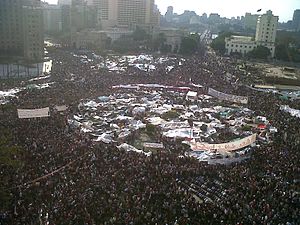Egyptian revolution of 2011
| 2011 Egyptian revolution | |
|---|---|
| Part of the Egyptian Crisis and the Arab Spring | |

Demonstrators in Cairo's Tahrir Square on 8 February 2011
|
|
| Date | 25 January 2011 – 11 February 2011 (2 weeks and 3 days) |
| Location |
Coordinates: 30°2′40″N 31°14′8″E / 30.04444°N 31.23556°E |
| Causes |
|
| Methods | |
| Result |
|
| Number | |
| 2,000,000 at Cairo's Tahrir square See: Regions section below. |
|
| Casualties | |
| Death(s) |
|
| Injuries | 6,467 people |
| Arrested | 12,000 |
The Egyptian revolution of 2011, locally known as the January 25 Revolution (Egyptian Arabic: ثورة 25 يناير; Thawret 25 yanāyir), began on 25 January 2011 and took place across all of Egypt. The date was set by various youth groups to coincide with the annual Egyptian "police day" as a statement against increasing police brutality during the last few years of Mubarak's presidency. It consisted of demonstrations, marches, occupations of plazas, non-violent civil resistance, acts of civil disobedience and strikes. Millions of protesters from a range of socio-economic and religious backgrounds demanded the overthrow of Egyptian President Hosni Mubarak. The revolution started by calls for protests from online youth groups. Initially these included liberal, anti-capitalist, nationalist, and feminist elements, but they finally included Islamist elements as well. Violent clashes between security forces and protesters resulted in at least 846 people killed and over 6,000 injured. Protesters retaliated by burning over 90 police stations across the country. The protests took place in Cairo, Alexandria and all major cities across the nation.
The Egyptian protesters' grievances focused on legal and political issues, including police brutality, state-of-emergency laws, lack of free elections and freedom of speech, corruption, and economic issues including high unemployment, food-price inflation and low wages. The protesters' primary demands were the end of the Mubarak regime and emergency law, freedom, justice, a responsive non-military government and a voice in managing Egypt's resources. Strikes by labour unions added to the pressure on government officials.
During the uprising, the capital Cairo was described as "a war zone" and the port city of Suez saw frequent violent clashes. Protesters defied a government-imposed curfew, which was impossible to enforce by the police and military. Egypt's Central Security Forces, loyal to Mubarak, were gradually replaced by military troops. In the chaos, there was some looting by gangs which was instigated (according to opposition sources) by plainclothes police officers. In response, watch groups were organized by civilians to protect neighbourhoods.
...
Wikipedia
